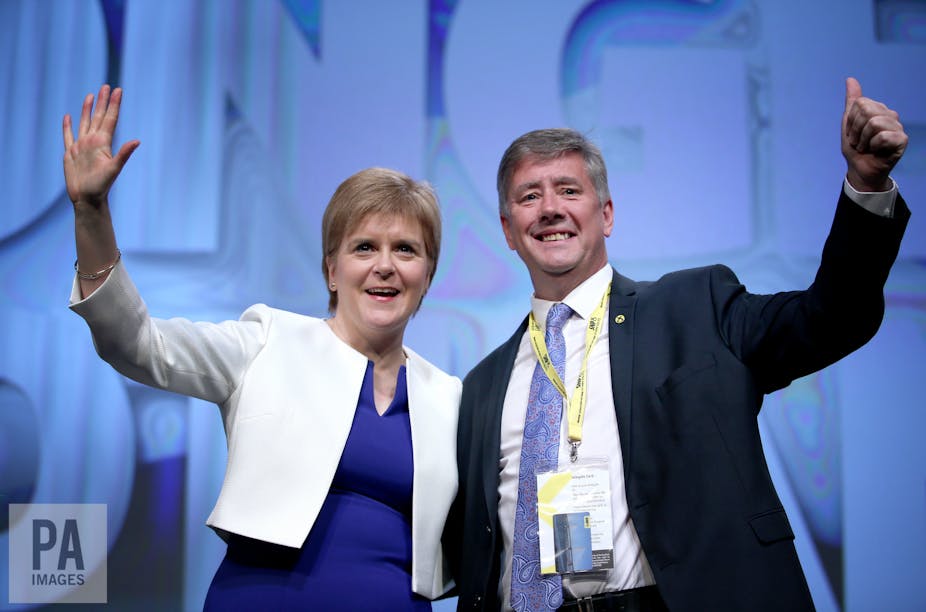White smoke from the Scottish Nationalists: Keith Brown has been elected the party’s deputy leader at the start of this year’s conference in Aberdeen. His 55.2% polling defeated nearest opponent Julie Hepburn’s 44.8% by a fairly modest margin.
Brown, the cabinet secretary for economy, jobs and fair work, was the only MSP standing after most major candidates decided not to enter the race. A former royal marine who fought in the Falklands campaign in 1982, he was considered the candidate of the party establishment. A rather dull but safe pair of hands, he had this to say about a second independence referendum in his victory speech:
I know that decision is in the safest of hands and I am absolutely confident that the person you have just selected me to deputise for – Nicola Sturgeon – will steer us towards that decision.
Hepburn is a longstanding party insider who is currently research manager for MP Stuart McDonald. She campaigned for badly needed internal reforms, arguing that the party has failed to capitalise on the large growth in membership in the months after losing the first referendum in 2014.

She was no protest candidate, but her final tally may have benefited from the votes of Chris McEleny, the left-leaning SNP councillor who was eliminated in the first round. McEleny had demanded a referendum be held within 18 months, and it would have been extremely uncomfortable for Sturgeon had he won.
In electing Brown the membership has backed the leadership’s wait-and-see position, but it’s hardly a ringing endorsement. It is the strongest signal yet of disquiet within the party over its direction on independence.
Separatist schism
The SNP is divided over an unenviable choice. Announce the date of a second referendum, knowing a defeat would be a near fatal blow to the main aim of the party – or wait and potentially lose the chance for years to come in the likely event that the Scottish parliament’s pro-independence majority is overturned in the 2021 election.
Sturgeon has indicated that she will decide in the autumn once the Brexit deal becomes clearer. She and her advisers are well aware that the fortunes of independence are tied to those of a party which has held power in Edinburgh since 2007.
Brexit continues to be the joker in the pack on attitudes to Scottish independence, however. Being outvoted by the English and Welsh on remaining in the EU has not made much difference to Scotland’s desire for divorce from the UK. Yet the National Centre for Social Research found earlier this year that more Scots believed leaving the UK would make Scotland better off than the opposite. Don’t rule out the possibility that fears around the economic impact of a hard Brexit are colouring this view.
Inextricably linked to the timing of the referendum is the issue of currency, an Achilles heel for the Yes movement last time around. Sturgeon duly set up a Sustainable Growth Commission to sketch out a new way forward. Chaired by former MSP and economist Andrew Wilson, it published a report last month arguing that Scotland should retain the pound for at least a decade and introduce tight controls on deficits and spending.
This was intended to be the start of a more reasoned case for independence that dealt with both the fears of 2014 No voters about the currency and concerns from business, particularly the financial sector. Instead, it has been problematic to say the least.
Predictably, Scottish Labour under the more left-wing leadership of Richard Leonard see an opportunity to revive the old jibe of the SNP being “tartan Tories”, attacking the report as a “cuts commission”. The first minister insisted that the report is anti-austerity – but days later the London-based Institute for Fiscal Studies undermined her by claiming it would in fact continue the austerity agenda.

Significantly, the SNP is not going to formally debate the report at conference – instead Keith Brown will now chair a series of national assemblies within the party that will debate it in the weeks and months ahead. Yet the report is a sure sign that after 11 years in power, the leadership has begun to lose its touch – compounding the feeling around the relatively poor results at last year’s UK election.
Challenge Nicola
Ahead of Brown’s lukewarm victory, pressure had already been growing on the party from grassroots organisations. A series of pro-independence rallies have been organised independently of the party by All Under One Banner. One, in Glasgow last month, attracted tens of thousands of supporters – the biggest public demonstration since the 2003 Iraq war. It clearly demonstrates that Yes supporters can still be mobilised.
The SNP is caught between supporters pushing for another referendum, especially those who are pro-EU, and the large proportion of the electorate who don’t want one. Support for independence is still less than 50% in the polls, but it is hard to be sure what to conclude from this. A pessimist would say it’s a signal not to hold another referendum – an optimist might say it is quite favourable considering the SNP has made little effort to mobilise support.

What’s evident is that, on the constitutional question, Scotland remains as divided as it was in 2014. It will take more than the applause for Sturgeon and her new deputy at this year’s rather stage-managed conference to make any inroads into that. The SNP leadership is performing a delicate balancing act, and finding it increasingly difficult to keep anyone happy. Whether Sturgeon can find a way back onto the front foot is going to be the ultimate test of her leadership in the coming months.

